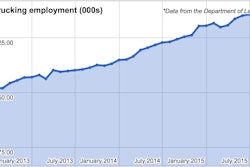
Tire pressure monitoring systems (TPMS), for instance, have come a long way since the early versions which tended to create as many problems as they solved.
Mini Lundqvist has been on the front lines advancing the technology. Like other TPMS products, he started with sensor caps that were designed to fasten onto valve stems and flash if the air pressure dropped below a minimum PSI.
Sometimes the caps leaked, he says. Also, the caps required extra time to remove in order to check tire pressure and inflate. The sensors did save time by eliminating unnecessary pressure checks but overall time savings was probably null, he says.
Furthermore, drivers had no way to detect a sudden leak while vehicles were in motion.
So Lundqvist, an engineer from Finland, went back to the drawing board. He interviewed fleet managers, truck drivers and spent time on the job with maintenance personnel.
“I created a wish list from everybody,” he says. “To my amazement I was able to fill every wish.”
The product he developed, TyreAid, is mounted on the hub with a hose assembly that equalizes the air pressure between dual tires. At 110 PSI, a difference of 5 PSI in either tire causes uneven wear for the under-inflated tire. The extra drag is the equivalent of 13 feet per mile, studies show.
Even if both tires have equal air pressure at rest, the inside tire tends to get hotter when in motion and pressure increases.
TyreAid’s equalizing valve automatically shuts off if the pressure difference is less than 4 PSI of normal inflation at 110 PSI, he says.
The product uses air hoses rated up to 2600 PSI. If a hose should get cut, however, a safety valve on both stems minimizes the leak rate to 10 PSI every 15 minutes, he says. The system flashes and sends the driver an immediate warning on a small, in-cab receiver display. A hose leak can be stopped immediately by unscrewing the safety valve.
The wheel-mounted device communicates a low pressure alert that is picked up by a receiver device in the cab. The device can also be used by fleet maintenance to check a yard full of equipment to find under-inflated tires. The receiver beeps if any are within 300 feet of range, he says.
The receiver display never has to be programmed. It does not identify the tire position; that is known by the flashing lights on the tire itself.
“We tried to keep it so simple for the maintenance and tire guy,” he says.
The product is designed for a 10-year life and comes with a 5-year warranty, including for battery life. The MSRP for TyreAid is $135 per tire which includes the receiver for the vehicle.











